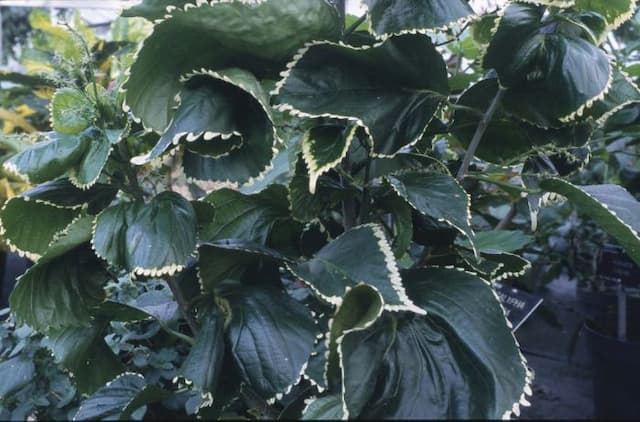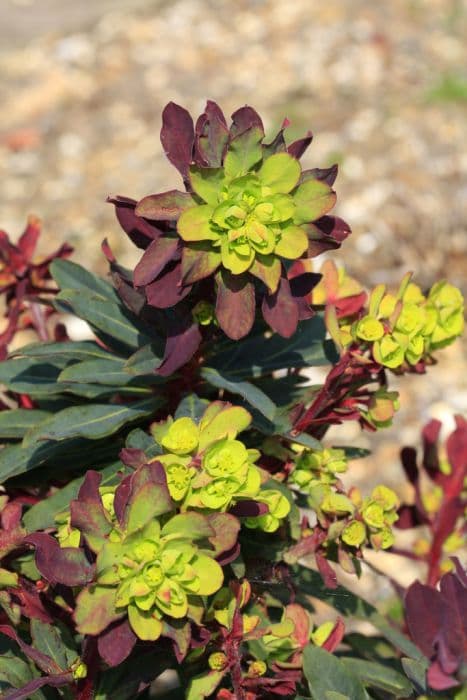Redwing Spurge Euphorbia Redwing = 'Charam' (PBR)
![spurge [Redwing]](/_next/image?url=https%3A%2F%2Fplants-admin.emdemapps.com%2Fimages%2Fplants%2F%2Fimages%2F604b60c0b72e4.png&w=3840&q=75)
ABOUT
Euphorbia Redwing, also known as 'Charam,' is a vibrant and eye-catching plant. This perennial is characterized by its attractive foliage and distinctive flowers. The leaves have a unique shape that creates a dense mound, displaying a blend of green and purplish-red tones. As the seasons change, the foliage may transition, offering a dynamic display of color throughout its growth cycle. One of the most striking features of the Euphorbia Redwing is the colorful bracts that often get mistaken for flowers. These bracts have a red or pinkish hue, which provides a stunning contrast against the darker foliage. The actual flowers of the plant are small and often clustered within the colorful bracts, which can sometimes be overlooked. The robust appearance of the Redwing is complemented by its active growth during the blooming season, where it produces an abundance of these ornamental bracts and flowers. The plant has a bushy, compact look, which makes it a popular choice for gardeners who want to add a splash of color to their borders or beds without the need for extensive pruning or maintenance. Its visual appeal is further enhanced when planted in groups, creating a striking tapestry of color and texture in the landscape.
About this plant
 Names
NamesFamily
Euphorbiaceae
Synonyms
Redwing Spurge, Characias Redwing
Common names
Euphorbia 'Charam' (PBR)
 Toxicity
ToxicityTo humans
Euphorbia 'Redwing', commonly known as Spurge, contains a milky sap that is toxic to humans. If the sap comes into contact with skin, it can cause irritation and dermatitis. If it gets into the eyes, it can lead to severe eye irritation or even temporary blindness. Ingestion of any part of the plant can result in symptoms such as nausea, vomiting, diarrhea, and abdominal pain. In severe cases, it could lead to more significant health issues due to its toxic principles.
To pets
Spurge is toxic to pets as well. The milky sap, when ingested or coming into contact with a pet’s skin, can cause irritation, resulting in symptoms like drooling, vomiting, and diarrhea. If the sap gets into the pet's eyes, it can cause intense burning and inflammation, possibly leading to temporary blindness. Prolonged exposure or ingestion of significant amounts can cause more serious symptoms and health risks to pets.
 Characteristics
CharacteristicsLife cycle
Perennials
Foliage type
Evergreen
Color of leaves
Green
Flower color
Red
Height
1 foot 2 feet (30-60 cm)
Spread
1 foot 2 feet (30-60 cm)
Plant type
Herb
Hardiness zones
6
Native area
Mediterranean
Benefits
 General Benefits
General Benefits- Easy to Grow: Euphorbia Redwing is a low-maintenance plant that is easy to grow, making it suitable for gardeners of all skill levels.
- Drought Tolerant: Once established, it has excellent drought tolerance, requiring minimal watering.
- Attractive Foliage: It boasts attractive foliage that adds texture and interest to the garden throughout the growing season.
- Long Blooming: Euphorbia Redwing produces bright red flowers that last for an extended period, ensuring a long-lasting display of color.
- Deer Resistant: The plant is resistant to deer, which helps to prevent it from being eaten in areas where deer are prevalent.
- Pest Resistant: It is generally resistant to common pests, reducing the need for chemical treatments.
- Versatile: This plant is suitable for a wide range of garden situations, including borders, rockeries, and containers.
- Attracts Pollinators: Its flowers attract pollinators such as bees and butterflies, benefiting the garden ecosystem.
 Medical Properties
Medical PropertiesThis plant is not used for medical purposes.
 Air-purifying Qualities
Air-purifying QualitiesThis plant is not specifically known for air purifying qualities.
 Other Uses
Other Uses- Artistic Inspiration: The vibrant bracts and unique form of Euphorbia Redwing can serve as inspiration for painters and illustrators who are looking for interesting and colorful natural subjects.
- Photography: Due to its striking appearance, the plant can be utilized as a photogenic subject for amateur and professional photographers, especially in macro photography.
- Educational Model: Euphorbia Redwing can be used in educational settings, such as schools or botanical workshops, to teach about plant structure and adaptations.
- Craft Material: Dried bracts and stems of the Euphorbia Redwing can be used in crafting, such as in the creation of natural wreaths or decorative arrangements.
- Living Fences: When planted in rows or clusters, they can act as a living fence or barrier without the need for constant trimming, unlike traditional hedge plants.
- Themed Gardens: It can be included in a "fire-themed" garden due to its red and green coloring, along with other plants that feature red, orange, or golden hues.
- Seasonal Decor: It can be utilized as a natural decoration during the holiday season when its colors coincide with typical holiday themes.
- Texture Contrast in Landscaping: Its unique texture can provide contrast when planted alongside plants with larger leaves or smoother textures.
- Costume Design: Parts of the Euphorbia Redwing could inspire or be used in theatrical costumes, especially for fantastical characters that require natural elements.
- Color Studies: The plant can be used in artistic color studies since it offers a range of greens and reds that can challenge and inspire artists to replicate or incorporate similar hues in their work.
Interesting Facts
 Feng Shui
Feng ShuiThe Spurge is not used in Feng Shui practice.
 Plant Symbolism
Plant Symbolism- Resilience - Euphorbias are known for their hardy nature and ability to thrive in harsh conditions, symbolizing the ability to endure challenging situations.
- Protection - The milky sap of Euphorbias can be an irritant, signifying a protective barrier against negativity and harm.
- Healing - Historically, some species of Euphorbia have been used for medicinal purposes, representing the power of healing and relief.
- Persistence - Euphorbias can grow persistently and often bounce back after being disturbed, embodying persistence and determination.
 Water
WaterThe Spurge, commonly known as Euphorbia Redwing, should be watered deeply but infrequently, allowing the soil to dry out slightly between watering sessions. In general, watering once a week with approximately one gallon of water per plant should suffice. During hotter and drier periods, you may need to water more frequently, perhaps every three to four days. Conversely, in cooler or rainy seasons, reduce watering to every other week or less, depending on soil moisture. Make sure to avoid waterlogging as Euphorbias are susceptible to root rot in overly wet conditions.
 Light
LightSpurge thrives best in full sun to partial shade. Place it in a spot where it can receive at least six hours of sunlight daily, though it can tolerate some shade in the afternoon. Avoid deep shade since insufficient light can lead to leggy growth and reduced flowering.
 Temperature
TemperatureEuphorbia Redwing prefers a temperature range between 50°F and 70°F but can tolerate temperatures as low as 30°F and as high as 85°F for short periods. The ideal growing conditions for this Euphorbia would be in an area with temperatures consistently nearing the middle of the preferred range, avoiding both the lower and upper extremes.
 Pruning
PruningSpurge benefits from occasional pruning to maintain shape, encourage bushiness, and remove spent flowers or any yellowed foliage. Pruning is best done in late winter or early spring before new growth begins. This plant typically requires pruning once a year, but if desired, light trimming can be done throughout the growing season to keep it tidy.
 Cleaning
CleaningAs needed
 Soil
SoilSpurge 'Redwing' prefers a well-draining soil mix with a slightly acidic to neutral pH between 6.0 and 7.0. A good recipe for the soil mix could include two parts peat or coir, one part perlite or coarse sand, and one part loam or potting soil.
 Repotting
RepottingSpurge 'Redwing' should be repotted every 2 to 3 years or when it has outgrown its current pot. Spring is the best time for repotting to allow the plant to establish in its new container during the growing season.
 Humidity & Misting
Humidity & MistingSpurge 'Redwing' tolerates a wide range of humidity levels but thrives best in moderate conditions. Aim for a relative humidity of around 40% to 60% for optimal growth and health.
 Suitable locations
Suitable locationsIndoor
Place Spurge 'Redwing' in bright, indirect light and keep soil dry between watering.
Outdoor
Plant Spurge 'Redwing' in full sun to partial shade in well-draining soil.
Hardiness zone
6-9 USDA
 Life cycle
Life cycleEuphorbia 'Redwing', commonly known as Spurge, begins its life cycle as a seed that, once sown, germinates in warm conditions. Seedlings emerge and gradually develop a root system and foliage, reaching the juvenile stage where characteristic leaves and branching patterns are established. As the plant matures, it enters the vegetative stage, growing vigorously with fleshy stems and red or purplish leaves. During spring and early summer, the Spurge enters the reproductive stage, producing distinctive, small green flowers surrounded by bright red bracts which are often mistaken for the flowers themselves. After pollination, capsules containing seeds form and, when mature, they burst open to disperse the seeds. The plant then enters a dormant stage in the latter part of the year, with reduced growth during colder weather, only to resume its growth cycle with the return of favorable conditions.
 Propogation
PropogationPropogation time
Spring-Early Summer
Propogation: Euphorbia Redwing, commonly known as Spurge, is most effectively propagated through cuttings. The best time to take cuttings is in late spring or early summer when the plant is actively growing. To propagate, one should select healthy stems and cut a 3- to 4-inch (approximately 7.5 to 10 cm) length using a clean, sharp knife or pruners. The cut end of the stem should be allowed to dry slightly to form a callus for a day before planting. The cutting can then be inserted into a well-draining soil mixture. It's crucial to keep the soil consistently moist but not waterlogged and to provide bright, indirect light until the cutting has rooted, which typically takes a few weeks. After rooting, the new Euphorbia can be transplanted into a larger pot or its final location in the garden.



![Spurge [Blackbird]](/_next/image?url=https%3A%2F%2Fplants-admin.emdemapps.com%2Fimages%2Fplants%2F%2Fimages%2F604b535f37783.png&w=640&q=75)





